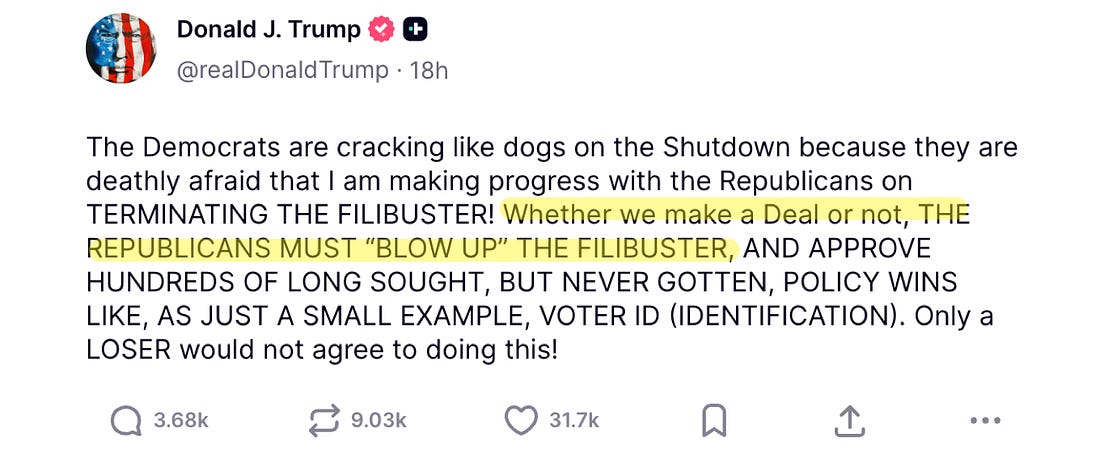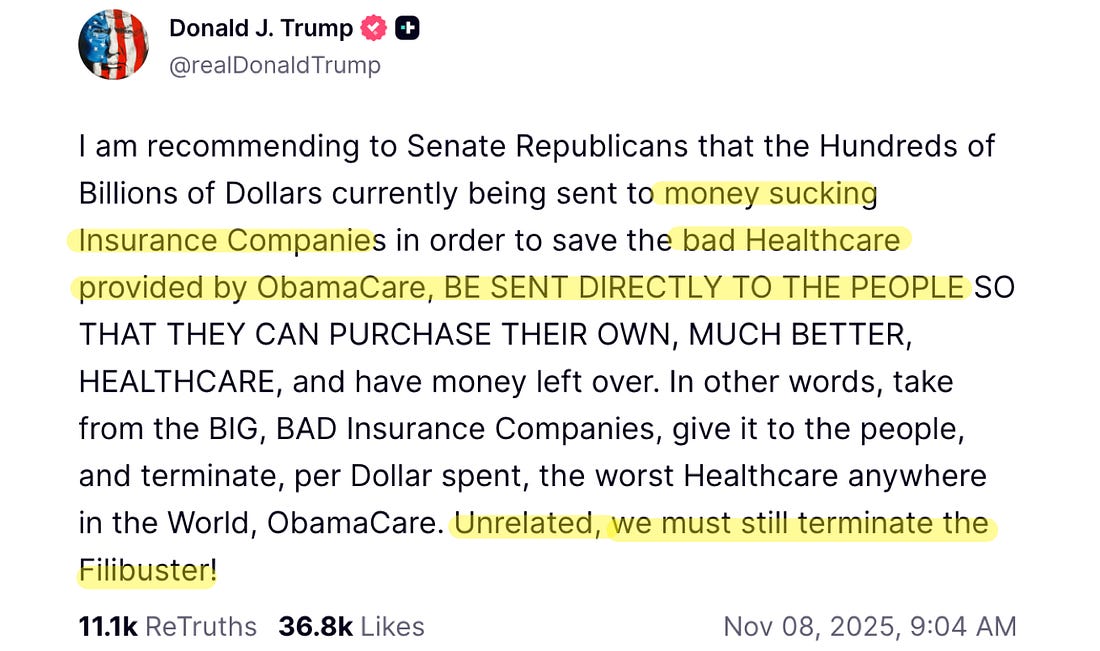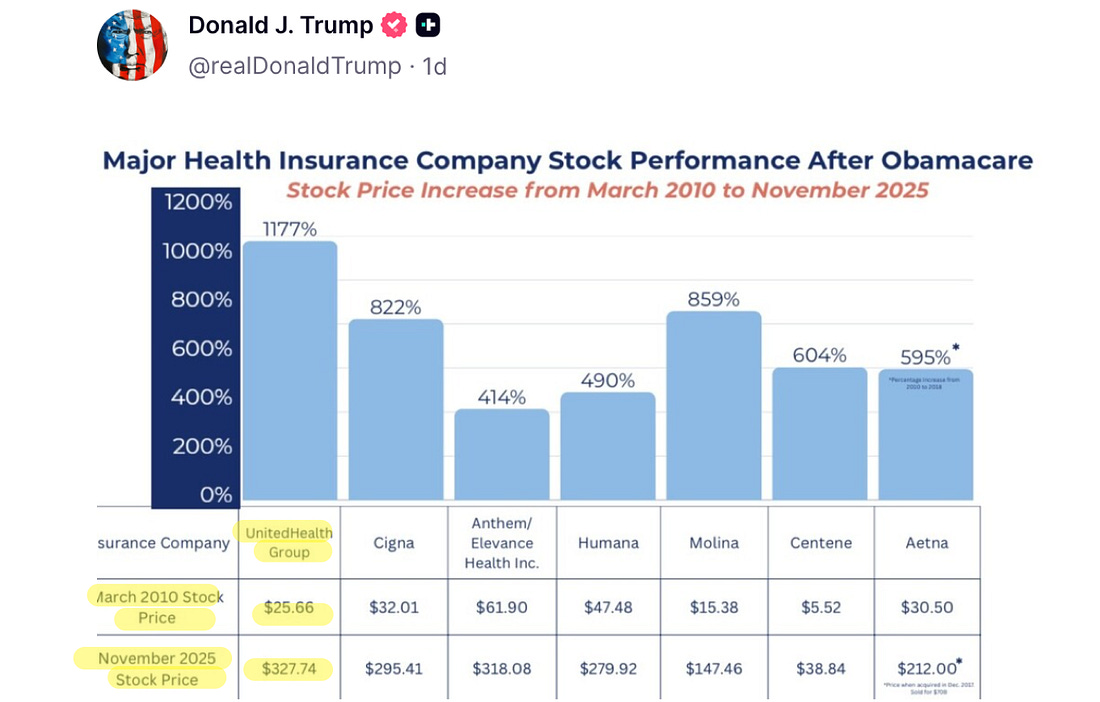C&C. UNAFFORDABLE. Military: Go Faster. Skewer Insurance Industry.
November 9 | Posted by mrossol | American Thought, Childers, Congress, Democrat Party, Pharma, TrumpMilitary tech race explodes: Hegseth cuts red tape; Russia debuts nuclear-powered missile; China unveils mobile ICBMs; Trump revives Cold War tests; Dems flail in shutdown; Trump skewers Big Insurance
Source: UNAFFORDABLE ☙ Sunday, November 9, 2025 ☙ C&C NEWS
WORLD NEWS AND COMMENTARY
🚀🚀🚀
The War Secretary belted out a wonky but fiery speech to 270 defense contractors this week. Air and Space Forces Magazine ran the story, headlined, “Hegseth: Pentagon ‘Fundamentally Reshaping’ Weapons Acquisitions.” He’s facing down his most dangerous enemy yet: the bureaucracy.
Among other unsightly messes, President Joseph Robinette Cabbage left behind a woke military with exactly zero hypersonic missiles in its inventory, whereas Russia and China are currently cranking out their second and third-generation versions. Russia’s hypersonics have even seen successful combat deployment.
You could say the U.S. isn’t leading the arms race; it’s still searching the car for its entry pass. We’re using Blackberries and the competition is on iPhone 26.
If there were a theme to Mr. Hegseth’s address to the defense contractors, it seemed like he wants things to go faster. He has a need for speed. “We’re injecting speed and agility into every facet, ensuring that we can outpace our adversaries,” Mr. Hegseth told the industrialists.
In fact, Hegseth said “speed” over 25 times in his speech. It was the untitled theme: Go faster. In a well-drafted speech rhetorically targeting the military’s most persistent enemy —Pentagon bureaucracy— Hegseth drilled down to a few specifics. For instance, he suggested the DoD will soon pay more for expedited delivery, a basic economic concept every Lil’ Caesar’s delivery driver already well understands.
The perennial topic was ripe for ironic mockery. For example, Hegseth announced the creation of a new, gold-star Wartime Production Unit, which sounds exciting— until you find out it is replacing 2023’s Joint Production Accelerator Cell, and then you deflate and realize that Hegseth is fighting an ancient buzzword battle that started shortly after George Washington ordered replacement boots for Army Brigade One, which were delivered right after General Lee surrendered at Appomatox.
Still and all, despite the fact that every single Defense Secretary since they built the Pentagon has delivered a similar speech, there were hopeful signs. One experienced Defense executive, who requested anonymity, said he was optimistic. “I think this administration is the best opportunity I’ve seen in my career for this to actually work,” he told Air and Space. “I’ve never seen more alignment across the services up and down the ranks for this type of stuff to get implemented… My confidence in it is growing.”
Hegseth needs to hurry. Thanks to Biden, the Autopen, and the Democrat kleptocrats, we are falling behind faster than ever.
🚀 In an obvious response to recent comments by President Trump that the US would restart nuclear testing, the Russians teased yet another weapons breakthrough. Reuters covered the story late last month, headlined, “Russia tested new nuclear-powered Burevestnik cruise missile.”
While the U.S. keeps missing the “go” button on its own hypersonic program, Moscow successfully launched its 9M730 Burevestnik (“Storm Petrel”) nuclear missile. It’s not a nuclear warhead; it uses a nuclear motor, so it can fly for a very long time. Russian officials said that, during its latest test flight, their nuclear-powered cruise missile soared for roughly 15 hours— over 8,700 miles.
Moscow claimed the rocket could defeat any existing missile shield technology. The reason is that a missile that can fly a long time can fly in unpredictable and non-linear ways, zigzagging, going up and down, approaching from unexpected directions, flying very low and very high. Modern missile-defense interception computers just don’t think that way.
It’s not that we can’t figure it out; it’s just going to take time and effort. But now, there are at least two major ways we’ve fallen behind in missile tech: hypersonics and now, propulsion systems.
The Wall Street Journal’s attempt to pooh-pooh the story is a great example, because it accidentally made the point. The sub-headline’s sneer failed, by arguing that we needn’t worry about this surprise new nuclear propulsion system because Russia has even more dangerous weapons (that we don’t):
But that wasn’t all.
🚀 A month earlier, in September, China rolled out its own surprise. Newsweek covered the story below the headline, “China unveils new nuclear missiles for “global” reach.” It is an ICBM —intercontinental ballistic missile— with record range capable of reaching Washington, DC from Beijing.
In lay language, China’s new DF-61 is claimed to have a range about +40% farther than US comparables (15,000 versus 9,000 miles), and more importantly, it is mobile. It can be launched from a truck rather than from a giant hole in the ground. For example, see this Asia Times headline, last month:
The article ungenerously but accurately referred to the US nuclear arsenal as “aging” and “silo-bound,” which makes us sound like a nursing home resident.
🚀 Finally, down at ground level, we face a new generation of drones. I don’t know about you, but I’m sick of hearing about drones. Drones this, drones that, they keep droning on. Still, large numbers of cheap drones might be the single most lethal battlefield weapons platform going.
And again, Biden left America on flat feet.
Not too long ago, the US led the world in drone tech. We watched it in Iraq and Afghanistan, where special forces could call down high-flying, unmanned, but very expensive platforms like the Predator to blow up a single terrorist hiding out in a third-floor apartment in Kabul.
But the Ukraine war changed everything. Biden’s team watched and did nothing.
Swarms of cheap drones don’t just add more flying bombs; they change the entire logic of combat. When a $1,000 kamikaze drone can destroy a $1M radar truck or a fuel depot, the cost calculus flips. Attackers buy in wholesale volume; defenders must accept losses at retail or do something different.
Thanks to drone swarms, troops and trucks can no longer afford to concentrate in one place. Armies must disperse, harden logistics, and give every small unit its own self-protection, like electronic jamming, short-range guns, cages, or directed energy weapons. Centralized, cathedral-style defenses —like big radars and big missiles— become more fragile and expensive.
Patriot air defense missiles are too expensive for shooting down drones.
Planes can no longer afford to park on “safe” airfields far behind the front lines. Planes —along with their fuel supplies and maintenance equipment— must now be housed in buried, hardened bunkers. Once again, thanks to Biden’s neglect, the U.S. is lagging. For instance, within 1,000 nautical miles of the Taiwan Strait, only two new “hardened air shelters” have been added since the early 2010s, while regional competitors have built many more.
It’s not just flying drones. There are also water drones, like the Houthis used to shut down an entire strait without risking a single skinny soldier. The old naval logic that deep water equals safety has inverted. Oh— I almost forgot: Russia and China are also leading with drone submarines. Once again, America lags far behind.
Last, but not least, swarms of cheap drones can saturate radar and missile defenses, letting more powerful cruise missiles slide through in all the electronic confusion.
One begins to understand why Hegseth said the word ‘speed’ so often. We have a lot of catching up to do.
🚀 All that helps explain another of this week’s big stories. The Hill ran the story, headlined, “Trump’s nuclear ambiguity: Will the US resume explosive testing?”
After a series of careful Cold War deals starting after the Cuban Missile Crisis, by 1996, the Comprehensive Nuclear-Test-Ban Treaty (CTBT) had finally outlawed all nuclear tests, whether above or below-ground.
On October 29-30, 2025, Trump posted on Truth Social that he had instructed the Pentagon (or “Department of War”) to “start testing our Nuclear Weapons on an equal basis” with Russia and China. It remains unclear what kind of testing: explosive warhead detonation, underground blasts, or non-explosive system tests. The U.S. Energy Department clarified the tests “will not include nuclear explosions” for now.
But on Wednesday, we finally tested a new missile of our own. NDTV World, Thursday:
Corporate media rushed to paint Trump as the aggressor— provoking varying responses from every other nuclear power in the world. But Trump isn’t starting anything. He is responding.
Trump isn’t starting a new nuclear race; he’s showing up to one that’s already halfway around the track. The old deterrence model —the frozen chessboard of silos and treaties— has been blown apart by hypersonic glide vehicles, ultra-long-range missiles, and next-generation mobile ICBMs that can hide, sprint, and re-aim in flight. Russia and China have been field-testing exotic systems for years, including nuclear-powered cruise missiles and sea-launched hypersonics. Each new platform chips away at the unspoken Cold War deal: that everyone’s bombs stay predictable, and therefore containable.
Media pretends that America’s vaunted deterrent —the quiet confidence that nobody would dare risk a first strike— looks less like a shield and more like a museum exhibit.
It’s easy to become alarmed by all this media chatter over weapons that can end civilization as we know it. But this new public debate is the beginning of the resolution of a growing problem the media studiously ignored during Biden’s term. It’s communications 101. We can’t resolve problems we don’t talk about.
Hopefully, this military roundup helps us understand that what’s going on isn’t chaos or brinksmanship. The Trump Administration is playing catchup; and by all appearances so far, playing well. As War Secretary Hegseth said, more, faster.
🔥🔥🔥
Early this morning, CBS ran a shutdown story headlined, “Senate holds rare Saturday session aimed at ending government shutdown, will reconvene Sunday.” They’re working a half-weekend— five hours yesterday, and they’ll resume today, on the Sabbath, at 1:30pm— after church and lunch.
In addition to the widely publicized SNAP saga, the Administration announced this week that U.S. flights are now being canceled thanks to the shutdown. CNBC ran the story yesterday, headlined, “Air traffic staffing shortages disrupt thousands of flights while FAA-mandated cancellations to worsen next week if shutdown continues.”
Apparently, air traffic controllers and security screeners are working without pay, and are starting to call in sick or something. It’s not completely clear. But 2,000 flights were canceled on Saturday (and 7,000 delayed) thanks to whatever the problem is. There were also a lot of thunderstorms, so it’s hard to know how many cancellations were shutdown-related.
But in spite of the increased squeeze on both ends of the economy —SNAPpers at the bottom, air travelers at the top— CBS said the Senate seems nowhere close to a deal to reopen the government. On Friday, Democrat Minority Leader Chuck Schumer seemed to give in, a little, publicly offering a compromise ‘deal’ for a single-year extension of Obamacare subsidies. (Democrats had previously demanded a ten year extension.)
President Trump responded promptly. He wasn’t impressed with Schumer’s fake “compromise,” and mocked Democrats who, he said colorfully, were “cracking like dogs:”
The allusion was not entirely clear; perhaps a concise combination of dog-faced pony soldiers breaking under the strain, cracking like walnuts, and barking. Or something. What can I say— classic Trump.
The truth that everyone knows, but media pretends isn’t true, is that all this public horse trading is only political posturing. The real dealmaking, if there is any, is happening behind the scenes, out of sight. Which brings us to the next remarkable story.
Trump launched a rhetorical ICBM at Big Pharma’s older brother, Big Insurance.
💉💉💉
It was yet more massive news that sprang entirely from two social media posts. CNBC’s version of the story carried the headline, “Trump tells Senate Republicans to send federal health insurance money ‘directly to the people.’”
The Childers family self-insures, because we can’t afford affordable health insurance. If we purchased an Obamacare plan, the premium for a plan comparable to our pre-Obamacare coverage —according to the website— would be $30,600 per year for our family of five. Using math, I determined that adds up to $306,000 every ten years.
But wait, it gets worse.
It isn’t easy to figure out, because they work hard to hide this part, but our “out of pocket” deductibles would amount to $6,000 per person, or another $36,000 in annual healthcare expenses (assuming we can afford to see the doctor at all with our ‘insurance’). That’s another $360,000 every ten years, or a princely sum of —I did not reverse engineer this— a demonic $666,000 every ten years.
For us, it is basically catastrophic-only coverage at this point. (That type of bargain-basement policy is now illegal.)
💉 Now behold the second astonishing Trump tweet yesterday, as the President stuck a lance into Big Insurance’s side, which ran straight through and out the other side, plunging into the Democrats’ brand-new campaign strategy:
Well, would you look at that? The most under-reported fact in the entire debate was just published on the President’s personal feed. (CNBC ignored it.) Taking UnitedHealth’s example: before Obamacare, its stock price was $25 a share. Now, it’s $327 a share. That’s an astonishing increase of thirteen times.
Lest you wonder whether that financial windfall was really the result of customer preference or great management, Trump also included the other big insurers, all across the board. Each in its turn saw its own stock prices multiply in the wake of the Democrats’ “affordability” plan. Affordability hasn’t hurt the insurance companies much.
The “subsidies” Democrats want are actually not subsidies for patients. They are direct payments to insurance companies, allegedly to offset their “losses” for providing Obamacare coverage. Now, thanks to Trump’s timely tweets, we all see who is really behind the shutdown: insurers.
Democrats are fighting to help insurers keep their massive “profits.” We should have seen it coming. Behold, a Stat News headline from August:
Hilariously, President Trump just told Senate Republicans to pay the $1.5 trillion the Democrats want for Obamacare “subsidies” straight to the patients. Cut out the middleman.
It was political checkmate.
💉 In two brutal posts, Trump peeled back the curtain and exposed the real driver of the shutdown: the insurance lobby. The same companies that turned “affordable care” into a stock-market miracle are the same ones now threatening to tank the government, stop SNAP, and cancel everyone’s vacation flights, unless their subsidies keep flowing.
They’re not lobbying for patients or providers. They’re lobbying for next quarter’s earnings call. Democrats call it “healthcare stability.” Wall Street calls it “recurring revenue.”
But Trump didn’t just skewer the insurers; he hijacked the Democrats’ favorite new word — affordability. He took their entire campaign plank, flipped it over, and signed his name on the bottom. Who’s against affordability now? The man proposing to send cash straight to taxpayers, or the party demanding it be laundered through Cigna first?
Democrats built an election-year altar to affordability. Yesterday, Trump waltzed in and swapped the candles for dynamite.
And the final twist: his message wasn’t really aimed at boomers or beltway wonks. Nobody likes health insurance. But Trump’s message was aimed straight at the one generation that despises health insurance companies with a moral passion— Zoomers. They can’t remember a world before prior authorizations and “out-of-network” mazes. They grew up watching their parents argue with bots over $87 copays. For them, “money-sucking insurance companies” isn’t a slogan, it’s trauma.
Trump just handed them a villain they already hate and a populist solution that fits perfectly in a meme.
Trump is wielding a live wire bursting with voltage. Zoomers’ “anti-corporate” subculture is treating Luigi Mangione —the guy who assassinated UnitedHealth’s CEO— as a kind of photogenic folk avenger, a meme-worthy, Ivy-League-educated Robin Hood in cargo shorts. The symbolism seems to matter more than the crime. To a generation priced out of healthcare and housing, Luigi’s violence wasn’t seen as a murder so much as a metaphor— rage against a system that bills you for breathing.
Polls now show that forty-one percent of Americans under thirty think it’s at least somewhat acceptable to kill an insurance CEO. Let that number marinate. To them, Luigi isn’t a murderer; he’s a patch update for late capitalism. They’ve traded faith in free speech and the ballot box for faith in chaos— because, as one sociologist told the Post, they no longer believe the system can be fixed, only crashed.
New York Post headline, four days ago:
For Zoomers, “affordable healthcare” is a unicorn in a lab coat. Everybody swears it exists, but nobody’s ever seen one in the wild. Most of them are freelancers, gig workers, or have starting salaries that barely cover rent. Employer plans are a fantasy; Obamacare deductibles are ransom notes; and “preventive care” means Googling your symptoms at 2 a.m. with a bag of frozen peas on your head. Zoomers are the most medically surveilled, least medically served generation in modern history— swiping on health apps they can’t afford to use.
Silly Democrats believed they owned the affordability issue. Their whole shutdown branding is constructed around “protecting affordable healthcare”— a neat slogan, focus-grouped to sound compassionate and working-class. But they completely misunderstand Zoomer rage. ABC headline, May:
The donor comments on Mangione’s GiveSendGo page must be seen to be believed. Folk hero might be an understatement. They’ve practically sainted him. “Luigi inspired me to rediscover my adventurous, carefree side – something I felt cancer had stolen from me – and replaced with fear,” one recent donor gushed, for a single example.
But Trump just linked Democrats’ affordability crusade directly to UnitedHealth’s balance sheet. In one stroke, he revealed “healthcare access” is a Democrat euphemism for corporate welfare. Goofy Democrats were chanting about helping patients; Trump showed the cash flow chart and revealed who the patient really is.
And what can you say about a President willing to take on one of the biggest and best-funded lobbies in the Milky Way Galaxy? Before Trump, no Republican president would have dared publicly compare the insurance companies to “money sucking” vampires or call them out as the real cause of the shutdown. But unlike Democrats, Trump can read the room.
We are watching a masterclass in modern political warfare: hit the lobbyists, steal your opponent’s theme, and win the meme war — all in two posts before breakfast.
Have a blessed Sunday! Thank you deeply for your continuing loyal support. I’ll meet you all back here tomorrow morning, to kick off another terrific week of Coffee & Covid.
























Leave a Reply
You must be logged in to post a comment.